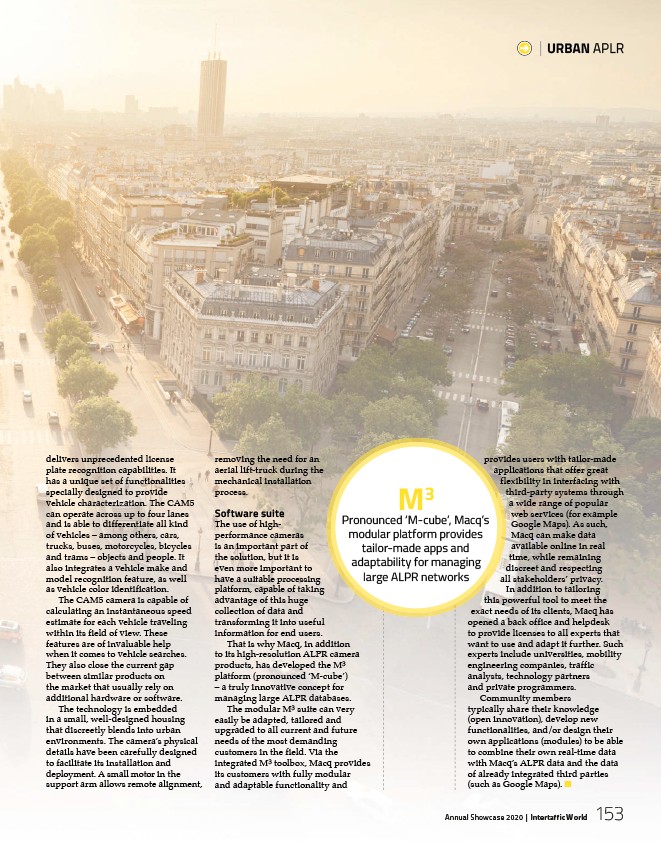
| URBAN APLR
Annual Showcase 2 2020 | Intertaffic World 153
delivers unprecedented license
plate recognition capabilities. It
has a unique set of functionalities
specially designed to provide
vehicle characterization. The CAM5
can operate across up to four lanes
and is able to differentiate all kind
of vehicles – among others, cars,
trucks, buses, motorcycles, bicycles
and trams – objects and people. It
also integrates a vehicle make and
model recognition feature, as well
as vehicle color identification.
The CAM5 camera is capable of
calculating an instantaneous speed
estimate for each vehicle traveling
within its field of view. These
features are of invaluable help
when it comes to vehicle searches.
They also close the current gap
between similar products on
the market that usually rely on
additional hardware or software.
The technology is embedded
in a small, well-designed housing
that discreetly blends into urban
environments. The camera’s physical
details have been carefully designed
to facilitate its installation and
deployment. A small motor in the
support arm allows remote alignment,
removing the need for an
aerial lift-truck during the
mechanical installation
process.
Software suite
The use of highperformance
cameras
is an important part of
the solution, but it is
even more important to
have a suitable processing
platform, capable of taking
advantage of this huge
collection of data and
transforming it into useful
information for end users.
That is why Macq, in addition
to its high-resolution ALPR camera
products, has developed the M3
platform (pronounced ‘M-cube’)
– a truly innovative concept for
managing large ALPR databases.
The modular M3 suite can very
easily be adapted, tailored and
upgraded to all current and future
needs of the most demanding
customers in the field. Via the
integrated M3 toolbox, Macq provides
its customers with fully modular
and adaptable functionality and
provides users with tailor-made
applications that offer great
flexibility in interfacing with
third-party systems through
a wide range of popular
web services (for example
Google Maps). As such,
Macq can make data
available online in real
time, while remaining
discreet and respecting
all stakeholders’ privacy.
In addition to tailoring
this powerful tool to meet the
exact needs of its clients, Macq has
opened a back office and helpdesk
to provide licenses to all experts that
want to use and adapt it further. Such
experts include universities, mobility
engineering companies, traffic
analysts, technology partners
and private programmers.
Community members
typically share their knowledge
(open innovation), develop new
functionalities, and/or design their
own applications (modules) to be able
to combine their own real-time data
with Macq’s ALPR data and the data
of already integrated third parties
(such as Google Maps). ■
M3
Pronounced ‘M-cube’, Macq’s
modular platform provides
tailor-made apps and
adaptability for managing
large ALPR networks